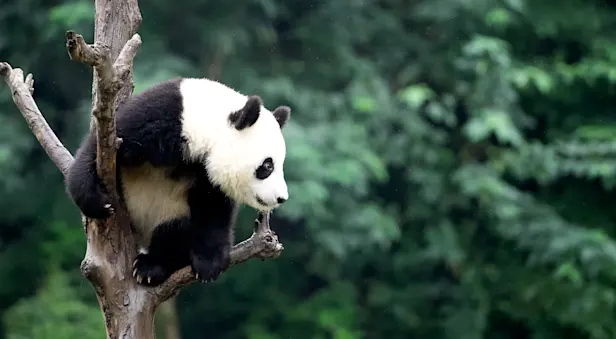Giant Panda Facts | China Wildlife Guide
The giant panda is perhaps the best-known and most loved animal in China. Chinese folklore recounts the story of a young girl, who had befriended the pandas. After her death the bears were overcome with sorrow and wept at her funeral. The black of their armbands rubbed off as they wiped their eyes, leaving dark patches behind. The pandas then hugged themselves, leaving marks on their hind legs, rumps, shoulders, and ears. This is the reason for the panda's unique coloring.
These shy creatures still haunt the forests and mountains of Sichuan Province. Though there are less than a thousand left in the wild, the panda has become a symbol of China and of her need to preserve her natural heritage.
Biology
More than 24 million years ago, bears and raccoons shared a common ancestor. This fact has resulted in a long-stemming argument over the pandas’ closest relative—raccoons or bears. Panda displays physical characteristics common to both bears and raccoons, however, current DNA and serology studies have found that pandas are most closely related to bears, particularly South America’s spectacled bear.
Physical Characteristics
Pandas are similar in size to American black bears. Adult pandas measure between four and five feet in length and weigh between 165 and 353 pounds; males tend to be 10 to 20 percent heavier than females. These creatures are mostly white, with black markings on their ears, arms, shoulders, hind legs, and eye patches. Some scientists speculate these patterns camouflage pandas in the wintertime. Others believe their distinctive coats allow the solitary bears to easily spot one another. And still others think the pandas’ black eyes and ears make them more intimidating to possible predators or enemies.
The thick coat of a panda has a warm, wooly under layer covered by a rougher outer layer. Its slightly-oiled fur prevents water from penetrating its surface as it roams the cool, wet bamboo forests. It has large molars and strong muscles extending from its jaw to the top of its head, which it uses to gnash the tough, fibrous stalks of its primary food source—bamboo.
Pandas have dexterous forepaws and extended wrist bones that function as opposable thumbs and help them handle bamboo. They walk upright and have hairs on their feet to retain heat and give them traction on ice and rock.
Habitat
Panda bears first appeared two to three million years ago in the regions of Eastern and Southern China, Northern Vietnam and Myanmar. Today, these bears inhabit six isolated forests in the Chinese Provinces of Sichuan, Shaanxi and Gansu, though fossil evidence shows they were once found as far north as Beijing. They live in high mountainous regions that contain natural forested areas of fir, spruce, and bamboo—usually from 8,500 to 11,500 feet above sea level. Currently, only 29 small, fragmented regions in the world can support the habitat and diet of the giant panda.
Giant pandas are typically solitary creatures except during the breeding season. Pandas usually live in well-defined territories; male territories, ranging from 1.5 to 2.5 square miles, often overlap several female territories, which average about 1.8 square miles in area.
Feeding Habits
Pandas belong to the family of carnivores and have a very similar digestive system to them. But millions of years ago, pandas adopted a vegetarian diet, perhaps because they were unable to compete with other carnivores for food. Giant pandas now feed almost entirely on bamboo stalks, sitting upright and collecting the leaves, stems and shoots with their forelegs. Although 95 to 99 percent of a panda’s diet is made up of bamboo, they will also eat flowers, vines, mushrooms, grass, fish and small rodents.
The digestive tract of a panda is only partially adapted to process bamboo. While they have a tough throat, esophagus, and stomach lining, their intestines are short and unable to digest cellulose from plant material. The panda’s inability to extract all the nutrients from bamboo means that they only process about 20 percent of their food (cattle can process about 60 percent of what they eat).
To compensate for the lack of nutrients, pandas eat large quantities of bamboo, consuming 33 to 66 pounds of food daily. They will feed for 10 to 16 hours a day, and usually sleep when not eating to conserve their energy.
Behavior & Communication
Giant pandas are most active at night and in the hours of twilight. Their eyes have vertical slit-shaped pupils, similar to other nocturnal creatures, which enable them to see in the darkness. Unlike many other species of bear, the panda does not hibernate, though it does move to lower elevations in the winter. Pandas make temporary shelters in caves and hollow trees, having no permanent den. They are for the most part terrestrial, though they are adept climbers and can swim.
During most of the year, pandas communicate by scratching on trees and rubbing acidic-smelling anal gland secretions on rocks and tree trunks. Each panda’s scent is unique and is used for personal identification. Pandas often leave scents to attract members of the opposite sex, or to mark their territory.
Giant pandas also communicate using their vocal repertoire; they perform up to eleven calls. Courting pandas will make a bleating sound to one another, and opposing males will bark to intimidate each other during the mating season. Pandas also use body language to communicate. Aggressive pandas bob their heads, showcasing their eyes and ears, while submissive pandas hide their eyes with their paws or turn their heads to the side.
Breeding
Panda’s reach sexual maturity between four and seven years of age, and the breeding season occurs once a year. Mating season lasts from March to May, and individual females remain in heat between two and seven days. During this period, a female may mate with several males.
After fertilization, the egg divides a number of times before free-floating in the uterus until implantation several weeks later. In June or July, the embryo finally attaches to the uterine wall and then continues development. This delayed implantation occurs so that cubs are born during stable climate conditions, between August and September.
The Young
Female pandas give birth to one or two cubs in a hollow tree or cave. The cubs weigh between three to five ounces—approximately 1/900 of their mothers’ weight. When two cubs are born, the weaker cub is often abandoned by the mother.
Pandas are born blind, pink-skinned, white-haired and entirely dependent on their mother. After two weeks, their skin turns gray where black fur will grow. Mothers start suckling their newborns immediately after birth. A cub will suckle fourteen times a day for up to 30 minutes at a time. Mothers will leave their den to feed making cubs vulnerable to predators such as snow leopards, yellow-throated martens and jackals. The rate of infant mortality is high due to predators and illness.
Infant pandas open their eyes at three weeks and don’t move on their own until 3 to 4 months of age, at which time they start to crawl. Cubs and mothers are often observed playing; the mother will roll her cub and wrestle with it, and the cub will climb on its mother’s back. They begin to eat bamboo at 5 months of age and are weaned at six months. The cub weighs 80 pounds at one year and lives with its mother until it is 18 months old. In the wild, the life expectancy of the panda ranges from 18 to 25 years.
Threats to Survival
Habitat Destruction
Though populations are rebounding after years of decline, pandas continue to be threatened by human activities. There are only about 1,864 giant pandas left in the wild, and habitat destruction is the most immediate threat to their survival. Between 1973 and 1984, the panda’s six remaining habitats were diminished by 50 percent. Many of these forests are exploited by human activities such as logging, conversion to agriculture and livestock grazing.
Food Sources
Bamboo also poses a question for the pandas' sustainability. Every 10 to 100 years, a species of bamboo will flower, seed, and die. Though the bamboo regenerates from seed after the first year, it can take up to 19 years before the bamboo is ready to sustain a population of pandas. Once a bamboo flowers pandas are forced to search out other regions for bamboo, since a single variety grows in a region.
The flowering of bamboo may have once had a positive effect on pandas’ health by maintaining genetic variation, as being forced to different areas in search of bamboo encouraged mating between diverse populations. As human populations increased, however, many forests were cleared for logging, agriculture, infrastructure, railroads and roadways. Now, habitat fragmentation has caused panda populations to become isolated in disconnected forests, and as a result, migration has become much more difficult.
Poaching
Pandas were once poached for their luxurious fur. In Japan, a panda's coat was worth about $176,000 in the mid-1990's. Today, however, strict laws have made poaching uncommon. Instead, the giant pandas are sometimes killed by traps and snares meant for takin and musk deer.
Conservation Efforts
In 1963 and 1964, China established the Wolong National Nature Reserve and the Wanglang Nature Reserve to preserve important panda habitats. The World Wildlife Fund has worked with China since 1979 to reduce human activity in crucial panda habitats, create green corridors, monitor pandas and forests for illegal activity, establish panda reserves, create awareness campaigns, engage with local communities, and further educate on conservation. In 2016, the IUCN upgraded the panda’s conservation status from “endangered” to “vulnerable,” after a 17 percent increase in the panda population since 2014. Protected panda reserves now encompass 3.8 million acres of forested habitat.
See Giant Pandas on These China Adventures

The Wild Side of China: A Nature Odyssey
Discover a side of China most travelers never see on our unique itinerary revealing wild panda habitat, rare wildlife and Chinese nature at its most entrancing—including close-up panda encounters.
































